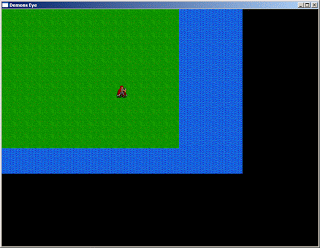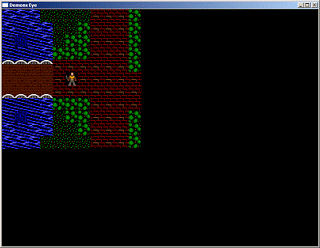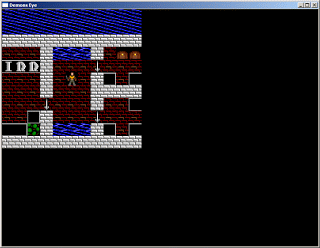 I’m finding it hard to keep track of how much time I’m actually spending on Demons Eye but I think my actual coding must be at about the 8 hour stage. The editor now has a working view and tile section for selecting tiles. Basically the cursor keys can be used to move around on the current map and the page up/page down buttons let you scroll through the tiles available. The left and right mouse buttons can be used to select tiles and place them down onto the map canvas. Some of these pieces of coding came together very quickly which was a pleasant surprise. The mouse coding in particular was very easy to do. The map structure is currently very simple with 2 layers – one for the landscape, walls, doors etc and another for monsters, characters and items. Ideally I should change the items into a linked list at some point to save on space and processing time. I’m also considering a third, middle level to cover decorative items – tables, rugs, blending tiles. This will allow me to reuse certain tiles over different base tiles without having to make multiple versions.I’m considering expanding the current tileset with some new landscpae tiles and will have a go at creating some of my own over the coming weeks. I think there are plenty of good monster, character and item tiles in David Gervais’ set so I should be fine there. A lot of features still to add to the editor before I’ll be able to really start using it but I’m making some progress.
I’m finding it hard to keep track of how much time I’m actually spending on Demons Eye but I think my actual coding must be at about the 8 hour stage. The editor now has a working view and tile section for selecting tiles. Basically the cursor keys can be used to move around on the current map and the page up/page down buttons let you scroll through the tiles available. The left and right mouse buttons can be used to select tiles and place them down onto the map canvas. Some of these pieces of coding came together very quickly which was a pleasant surprise. The mouse coding in particular was very easy to do. The map structure is currently very simple with 2 layers – one for the landscape, walls, doors etc and another for monsters, characters and items. Ideally I should change the items into a linked list at some point to save on space and processing time. I’m also considering a third, middle level to cover decorative items – tables, rugs, blending tiles. This will allow me to reuse certain tiles over different base tiles without having to make multiple versions.I’m considering expanding the current tileset with some new landscpae tiles and will have a go at creating some of my own over the coming weeks. I think there are plenty of good monster, character and item tiles in David Gervais’ set so I should be fine there. A lot of features still to add to the editor before I’ll be able to really start using it but I’m making some progress.





